Family Stress Theory Notes
0.0(0)
0.0(0)
Card Sorting
1/20
Earn XP
Study Analytics
Name | Mastery | Learn | Test | Matching | Spaced |
|---|
No study sessions yet.
21 Terms
1
New cards
Defining Stress: What is stress?
Stress is the body’s response to events that pose a threat to one’s physical or emotional well-being, whether they are pleasant or unpleasant
2
New cards
Defining Stress: What are the negative effects of long-term exposure to stress?
Long-term exposure to stress can diminish the body’s ability to cope with stress, leading to physical and emotional exhaustion, fatigue, anxiety, depression, and other physical health problems.
3
New cards
Nature of Stress: what is stressors?
External event that cause emotional of physical reaction. Stress is the body’s reaction to demands, which can be positive (eustress) or negative (distress).
4
New cards
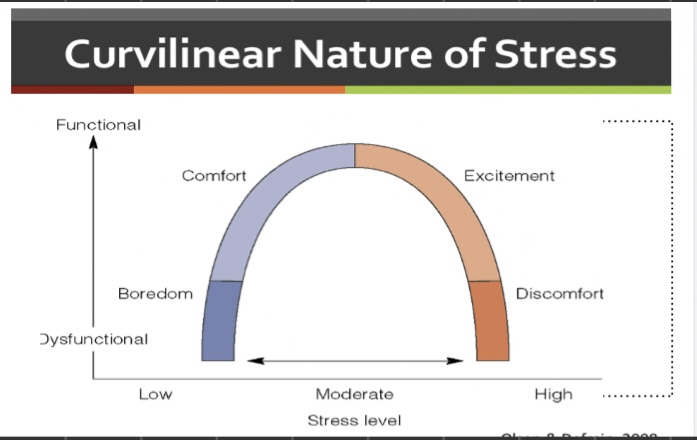
Nature of stress: What is the curvilinear nature of stress?
Stress can have pos and neg effects on well-being’s depending on length and level of exposure. This is known as the curvilinear nature of stress. By managing stress effectively, individuals can maintain their physical and emotional wellbeing.
5
New cards
Stress and Life Events: What is the Social Readjustment Rating Scale (SRSS)? Holmes and Rahe
The SRSS is a scale developed by Holmes and Rahe to measure life events that require behavioral changes or readjustments. Each event is assigned a score based on the amount of readjustment needed.
6
New cards
Stress and Life Events: What is the relationship between life events and physical and emotional health?
Studies have found that a high number of stressful life events can increase the risk of developing physical/mental health problems. It’s important to manage stress effectively by practicing relaxation techniques, or seeking support. By taking proactive measures, individuals can improve their overall well-being and reduce neg. effects on body and mind.
7
New cards
Basic Assumptions: What factors influence the degree to which stressors affect a family?
Stressors have their own characteristics that influence the degree to which they affect the family. These factors include whether the stressor is internal or external t the family, focused on one member or all members, how long it wil take to adjust, whether it is natural or human-,add, whether it was sudden or a gradual onset, hows severe the stressor is, whether it was expected, and whether the family thinks they can solve the stressor. There are three types of stressors: normative (expected) vs. non-normative, ambiguous (don’t know basics) vs. non-ambiguous, and volitional (we want to happen) vs. non-volitional.
8
New cards
Basic Assumptions: What resources impact a family’s resilience or vulnerability to crisis?
Being able to access existing and new resources during times of stress impacts a family’s resilience or vulnerability to crisis. Resources can be categorized into three categories: individual, family, and community. Family members should stick together as a cohesive unit and pull together to help each other, but also learn when they should go outside of the family and seek help. Social support is one of the most important resources we can access, as it can help families instrumentally (chores, write a resumé), emotionally, and through building of increased social networks (social group online)
9
New cards
Basic Assumptions: How does an individual and/or family’s cognition appraisal of their stressors impact crisis?
An individual and/or family’s cognition appraisal of, or definition of, their stressors impacts the degree of crisis they are likely to encounter. Interpretation is important when determining how a family will react to crisis. Not believing it will be solved is dooming for failure. An important part of the process is how the stressor is broken down into manageable parts.
10
New cards
Basic Assumptions: What determines whether a family will enter a state of crisis?
Whether a family will enter a state of crisis is determined by the A, B, and C components of the model. Crisis is reached when the family is no longer able to maintain its usual balance because of a stressor.
11
New cards
Family Stress Theory
relation to other theories, focuses on family systems in transitional or stressful stage, Reuben Hill is the father of family stress theory
12
New cards
Hills Assumptions
1. Unexpected or unplanned events are usually perceived as stressful (normative vs. nonnormative)
2. lack of previous experience with stressor events causes greater stress
1. ambiguous stressor events are more stressful than non-ambiguous events
13
New cards
Roller-Coaster Profile of Adjustment to Crisis components
1. Crisis - stress-provoking event (death, new baby)
2. Disorganization - follows as members try to cope with situation (develop schedule around baby)
3. Recovery - figure out how to handle
4. Reorganization - can be same, better, or stable but lesser than before

14
New cards
hill’s ABC-X Model of Family Stress (foundation of FST) components
1. Stressor (a)
2. Resources (b)
3. definition (c) - family’s perception of event, definition/meaning
4. the crisis (x) - occurs if family can’t immediately figure out how to solve problem
The interaction of these events determine crisis experience and this model focuses on one stressor at a time
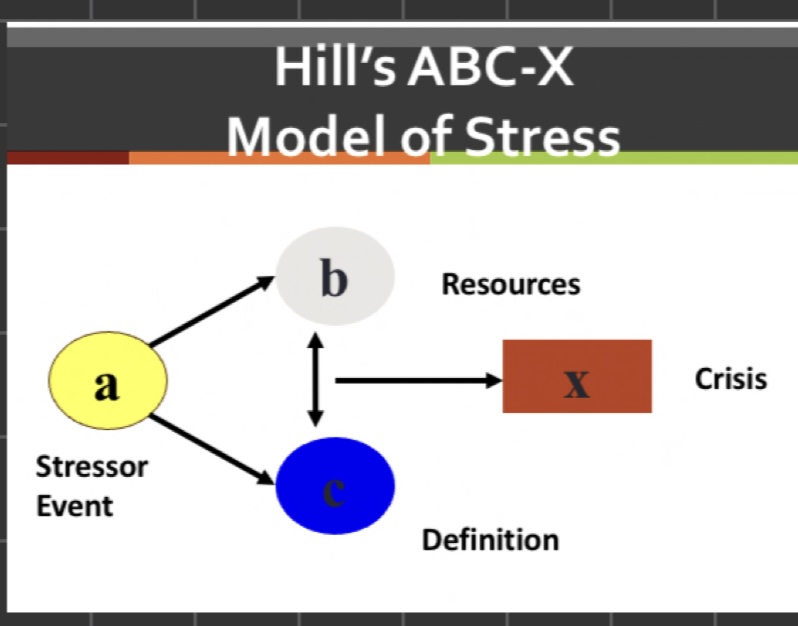
15
New cards
McCubbin’s Assumptions
1. pileup of family demands creates more stress
2. family strengths (cohesion, flexibility, communication) help adaption
3. family resources are related to family adaption
4. family’s positive attitude helps in coping
16
New cards
Double ABC-X Model (McCubbin and Patterson)
aA-pileup - three components: initial stressor, changes in the family, and stressors resulting from attempting to cope with initial stressor
bB - existing and new family resources
cC - perception of aA and bB and X: concerned with family’s response to initial stressor, interpretation of previous responses to crisis situation, and how their perception might change over time
xX-adaption (bonadaption-maladaption) - post-crisis adaption hinges on how the family has adapted to crisis and new level of family functioning
bB - existing and new family resources
cC - perception of aA and bB and X: concerned with family’s response to initial stressor, interpretation of previous responses to crisis situation, and how their perception might change over time
xX-adaption (bonadaption-maladaption) - post-crisis adaption hinges on how the family has adapted to crisis and new level of family functioning
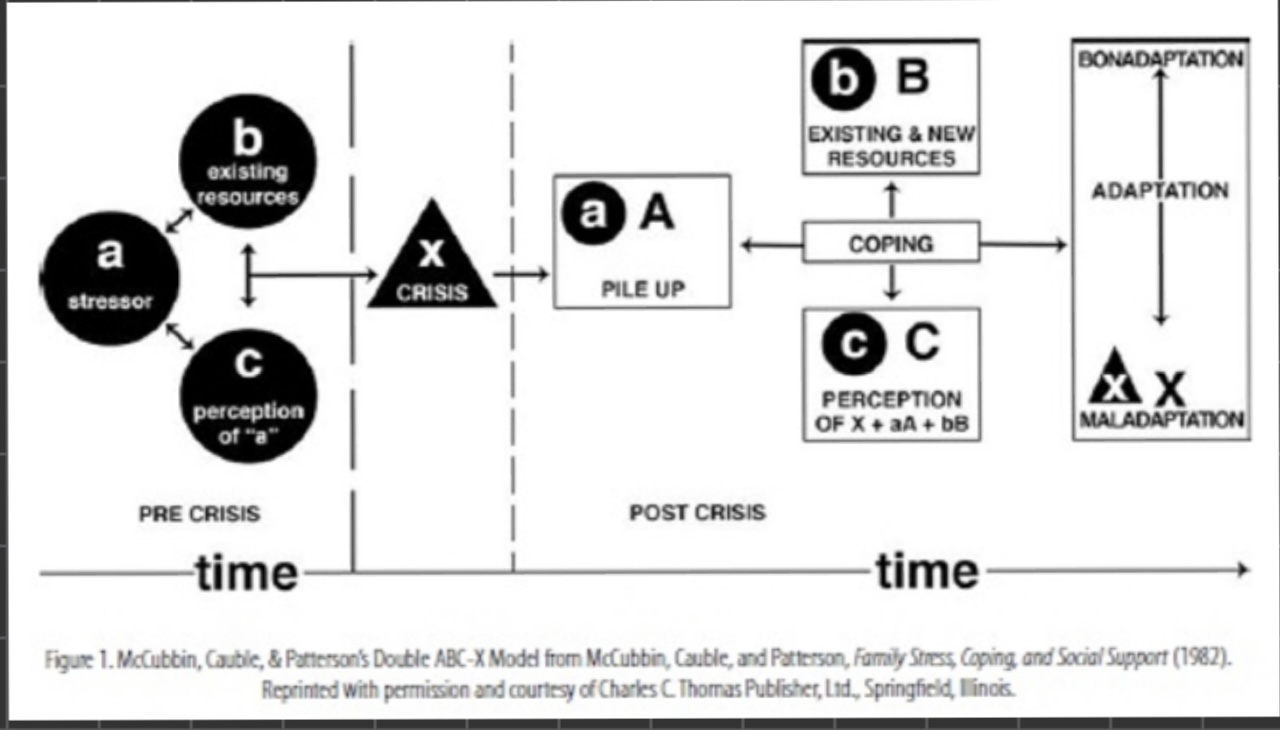
17
New cards
Example of ABC-X Model
family death of child → use of resources → the family’s ability to “make sense of a situation” → does the situation make or break the family?
18
New cards
McCubbin FAAR Model’s emphasis
Emphasizes adaption as the central outcome of the stress process and focuses on potentially positive outcomes. It identifies family and individual resilience in relation to stressors and risk factors
19
New cards
FAAR Model’s attempts
1. Families attempt to maintain homeostasis or balance the stressors they face with their capacity (resources, coping) to deal with them (ability to achieve balance is influenced by meaning/definition/interpretation of situation)
1. Meet demands, range from good—poor, reflected in mental/physical health, optimal role performance, and preservation
2. Doesn’t meet demands, experience crisis
1. Go into adaption phase, model looks at how family reduce or eliminate demands, obtain more resources/coping strats, and/or modify perspective
2. Processes used to adapt/restore balance are viewed on levels: individual, family members, family unit, and community
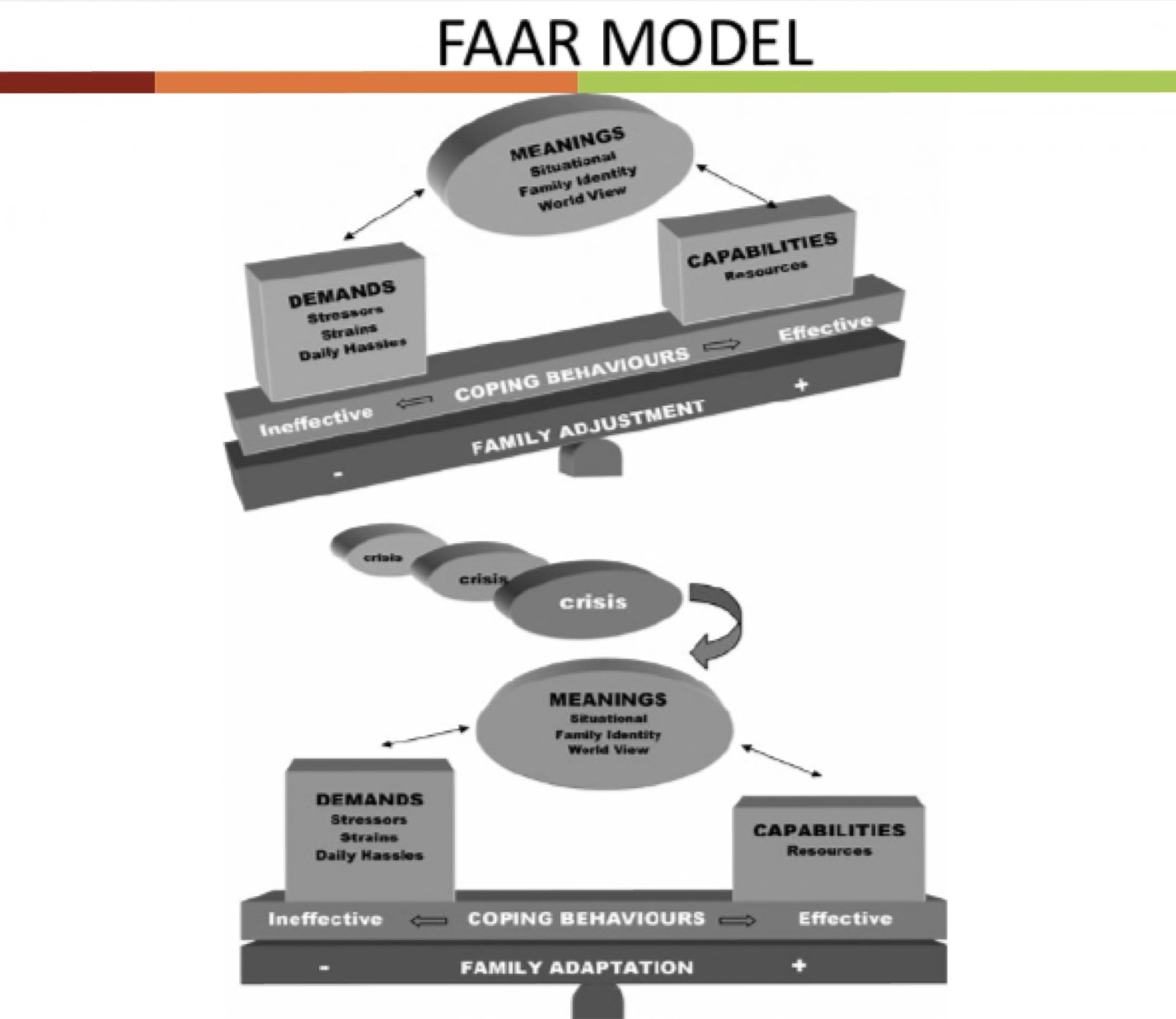
20
New cards
What did Boss’s Contextual Model add to the original
Added external (no control over: culture) and internal (control: beliefs) context to the original model
21
New cards
What was Boss’s Contextual Model major contributions?
It was the theory of ambiguous loss (A) which is a type of stressor that is a complicated loss that is unclear, unverified, and unresolved. There is two types:
* physical but psychological presence (kidnapping, missing, military)
* Psychological but physical presence (Alzheimer’s, unhealthy obsesssions)
This contributes to the perception (c) of boundary ambiguity: increase levels of boundary ambiguity can negatively impact on family well-being → Boss developed guidelines for therapeutic practices
* physical but psychological presence (kidnapping, missing, military)
* Psychological but physical presence (Alzheimer’s, unhealthy obsesssions)
This contributes to the perception (c) of boundary ambiguity: increase levels of boundary ambiguity can negatively impact on family well-being → Boss developed guidelines for therapeutic practices
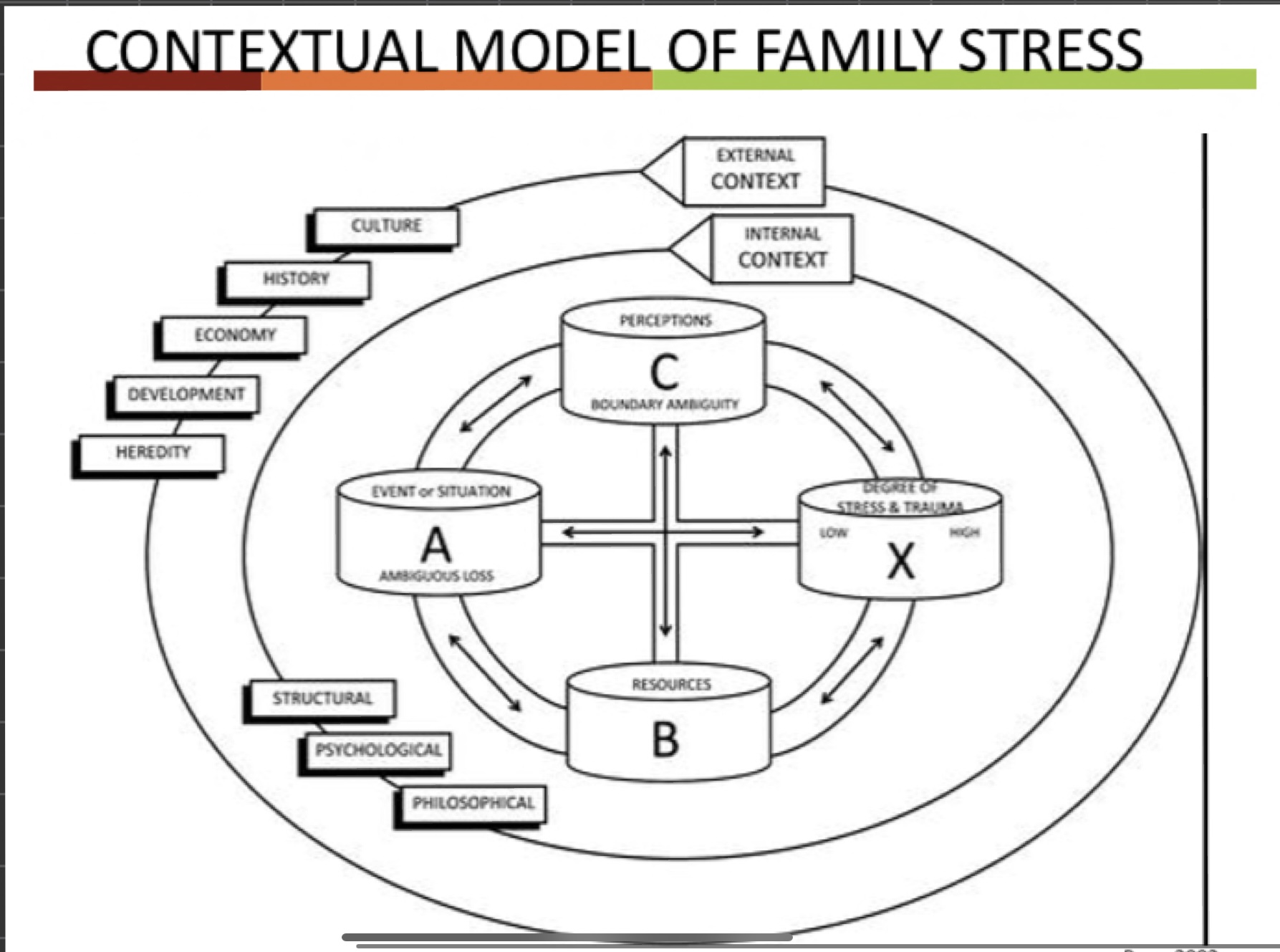
Explore top notes
Explore top flashcards
AP Euro Topic 1.7 Rivals World Stage Terms and Names (Amsco Bolded),
Updated 447d ago